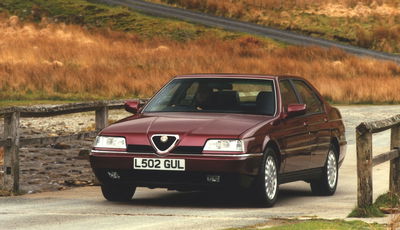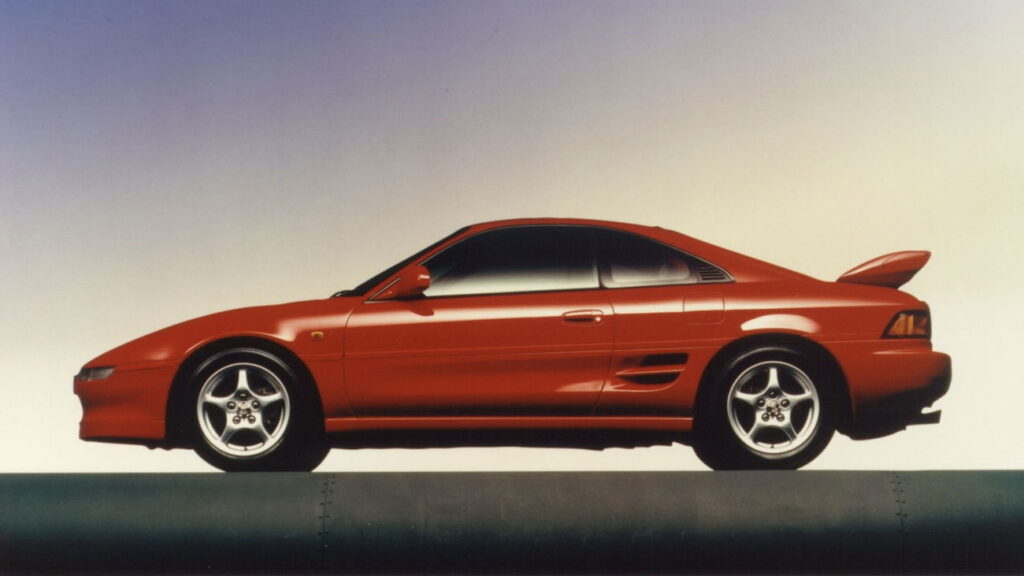1990s cars are a big deal at the moment. The generation that grew up on Gran Turismo is starting to grow up and make proper money, and as a result, automotive nostalgia for the last decade of the 20th century runs higher than perhaps any other.
That, sadly, has driven prices a bit mad, and lots of legendary ’90s performance cars that would have cost about as much as an average pub trip 20 years ago are now breaking auction records.
That doesn’t mean there aren’t still cheaper ways of jumping on the ’90s hype train, though. Join us for a look at 10 second (or third, or fourth)-hand cars from the 1990s that can be bought for under our usual budget of £10,000.
Toyota MR2 SW20
Toyota MR2 SW20
Get your snap oversteer jokes out of the way now – there’s a reason the second generation of Toyota’s Midship Runabout 2-Seater is many folks’ favourite. With its smoothed-off, shrunken supercar looks, it couldn’t have more of a ’90s vibe if it tried.
It was a proper little sports car, too, more physical to drive than some rivals, and it had a range of four-cylinder engines that were gutsy enough to exploit its low weight and lively chassis. If you’re really feeling brave, you could even track down a turbocharged Japanese import with 218bhp. With rumours of the MR2’s return gathering pace, now might even turn out to be a very good time to buy one.
Alfa Romeo 164

Alfa Romeo 164
Becoming part of the Fiat empire may have forced Alfa Romeo’s hand in moving onto a shared front-wheel drive platform for its 164 exec saloon, but Alfa still had plenty of freedom to make it feel different from the closely related Fiat Croma, Lancia Thema and Saab 9000.
It had a totally different front suspension setup to its siblings, which, when paired with Alfa’s raspy 3.0-litre V6, made it just as exciting to drive as its rivals. It was all topped off with a wedgy Pininfarina body that looks as sharp and uncluttered now as it did 30 years ago.
Subaru Impreza Turbo 2000
Subaru Impreza Turbo 2000
The ’90s saw the beginning of the Subaru Impreza versus Mitsubishi Evo rivalry that spilt over into the next decade and still divides enthusiasts today. Most of the key players from this fight have long since been subject to skyrocketing prices, but you can still comfortably pick up a UK-spec Impreza Turbo 2000 in budget.
This was essentially our version of the original JDM WRX, albeit with a detuned engine that put out a fairly meagre 208bhp. It wasn’t a heavy car, though, and so would still hit 62mph in just 5.8 seconds. What’s more, you’re still getting those Subie signatures – a burbly turbo flat-four, and that all-wheel drive system that could have been tailor-made for Britain’s wet, slippery roads.
Citroen XM
Citroen XM
Not a lot does exquisite comfort like a big Citroen saloon, and the XM, launched in 1989, was no different. Equipped with the latest version of the company’s party-piece self-levelling hydropneumatic suspension, it boasted ride comfort that would make driving a contemporary 5 Series feel more like being dragged along the road behind it.
The tricksy suspension also kept things flat in the corners, making the XM a decent performer, especially when fitted with the range-topping 3.0-litre V6. Interior space was enormous, and it was topped off with that wedgy Bertone silhouette that looked like something from a ’90s sci-fi film.
Range Rover P38
Range Rover P38
The shortest-lived of all the generations of Land Rover’s flagship, 1994’s P38 was nonetheless Range Rover through-and-through. The build quality was a bit iffy, for a start. But it was the first Rangie to really go all-in on luxury and on-road manners, without much compromise in off-road ability.
Available with a couple of different Rover V8s (the ones you want) or a BMW turbodiesel straight-six (the one you should probably get), the P38 is stately without being showy, as a Rangie should be, and to this day looks as at home in Mayfair as it does on a muddy farm track. When it’s working, anyway.
Ford Puma
Ford Puma
Long before it was a small crossover lapped up by the British public like a big cup of tea on wheels, the Ford Puma was a relatively short-lived Fiesta-based coupe, introduced in 1997. Available with a range of fizzy four-pot engines, it wasn’t hugely powerful, but it was light and blessed with one of the sweetest front-wheel drive chassis of all time.
Many of them are lighter still these days, because unfortunately, they have a tendency to rot like a piece of paper in a rainstorm, but if you can find a good one, it’ll serve as a reminder that big power and rear-wheel drive aren’t necessary to make an exciting car.
BMW 7 Series E38
BMW 7 Series E38
We can argue all day about the peak of BMW design (hint: it’s certainly not to be found in anything the company’s making today), but the third-generation E38 7 Series is surely in with a shout. Everything about it, from its perfect saloon proportions to its minimalist detailing, is just so right.
Power came from straight-sixes, V8s or even a V12, and because it was a BMW, it dealt with corners nicely for such a big old barge too. Then there was the interior, with acres of space and the finest in-car technology the mid-to-late ’90s could offer. Pretending to be a Munich-based businessperson circa 1997 has never looked so appealing.
Volkswagen Corrado
VW Corrado
On an ancient episode of Top Gear, a fresh-faced Richard Hammond touted the VW Corrado as a surefire future classic that you’d be able to enjoy and then sell on for a decent profit. 22 years later, was he right? Sort of.
The slightly posher successor to the first two generations of Scirocco has certainly shot up in price from those early noughties days when you’d have potentially been able to track one down for three figures, but they’ve escaped the fate of lots of contemporaries, with both supercharged G60s and 2.9-litre VR6s falling into our budget. They seem to look better with every passing day, too. You could even get one in red, ship it to Colorado and recreate the early stages of the original Forza Horizon. If you really wanted to.
Peugeot 306 GTi-6
Peugeot 306 GTi-6
The 1990s were generally considered a pretty dire period for hot hatches, with laughable insurance premiums threatening to kill them off entirely. There were some bright spots, though, and at the more attainable end of the scale is the Peugeot 306 GTi-6.
A 2.0-litre 16-valve engine with a healthy 167bhp provided power, while the chassis hailed from a time when Peugeot was knocking out some of the best-driving ‘normal’ cars around. At a time when the Golf GTI was underpowered and overweight, and the best Ford could manage was the dismal Mk6 Escort RS2000, the GTi-6 was really the only hot hatch to go for, and it’s still temptingly attainable today, even as prices begin a gradual uptick.
Mazda MX-5 NA
Mazda MX-5 NA
Yeah, yeah. We know. This is the most painfully predictable choice imaginable. There’s a reason the original Mazda MX-5 is beloved to the point of cliché, though.
That perfectly balanced chassis. Those fizzy, responsive and hugely reliable naturally aspirated engines. The simple joy of undoing a couple of clips and throwing the roof back. The expertly judged looks are topped off by possibly the cutest pop-up headlights ever. The unfortunate tendency to turn into a pile of scrap metal if driven on a slightly damp road. Okay, maybe not that last one, but find a clean NA, and if you don’t already understand the hype, you soon will.
Read the full article here


